Making Invisible Histories Visible
Page Navigation
- Making Invisible Histories Visible
- Lesson Plans and Resources
- iBooks on Omaha and Nebraska History for Primary Students
- Omaha Mapping Projects
-
African American Histories
- African American Artists
- African American Athletes & Facilities
- African American Churches
- African American Civil Rights Organizations - 1950s-1960s
- African American Civil Rights
- African American Contributions to Jazz, Gospel, Hip-Hop
- African American Dramatic Arts
- African American Education - Dorothy Eure & Lerlean Johnson
- African American Educators & Education
- African American Firefighters
- African American Homesteaders
- African American Law Enforcement
- African American Migration to Omaha
- African American Musicians of Omaha
- African American Newspapers
- African American Owned Businesses
- African American Politicians
- African American Social Life
- African American Workers at Omaha's Railroads & Stockyards
- African American Workers at the Naval Ammunition Depot in Hastings
- African Americans in the Civil War
- African Americans in Vietnam
- Charles B. Washington - Journalist and Civil Rights Leader
- Elizabeth Davis Pittman - Lawyer/Judge
- Green Book Omaha
- Marlin Briscoe - Professional Football Player
- Native Omaha Days
- Nebraska's Role in the Underground Railroad
- Sen. Edward Danner - Politician & Civil Rights Activist
- Sudanese Refugees
- Tuskegee Airmen
- European and Asian Immigrant Histories
-
Historic Neighborhoods & Buildings
- 24th and Binney/Wirt/Spencer Streets
- 24th and Lake Streets
- Central Park Neighborhood - 42nd and Grand Avenue
- Dahlman Neighborhood - 10th and Hickory Streets
- Hartman Addition Neighborhood - 16th and Williams Streets
- Indian Hills/Southside Terrace Neighborhood - 30th and Q Streets
- Jefferson Square Neighborhood - 16th and Chicago Streets
- Long Neighborhood - 24th and Clark Streets
- Orchard Hill Neighborhood - 40th and Hamilton Streets
- Smithfield Neighborhood - 24th and Ames Avenue
- St. Mary's Neighborhood - 30th and Q Streets
- Latino Histories
- Music Histories
-
Native American Histories
- Black Elk and John G. Niehardt
- Chief Standing Bear and Susette La Flesche Tibbles
- Dr. Susan LaFlesche Picotte - Native American Doctor
- Native American Education and Boarding Schools
- Native Americans in the Military
- Pre-statehood Interaction of Native Americans and Europeans
- Preserving Native American Tradition
- Restoring the Ponca Tribe
- The American Indian Movement in the 1960s and 1970s
- The Indian Congress at the 1898 Trans-Mississippi Exposition
- The Omaha Native American Indian Tribe
- OPS Elementary School History
- Redlining in Omaha
- Nebraska's Role in the Underground Railroad
- The 1898 Trans-Mississippi Exposition
24th and Lake Streets
-
"How can we maintain the integrity of our culture but provide all sorts of excitement? A place where people come from out of town and say let’s go to North Omaha and do such and such." -Preston Love Jr.
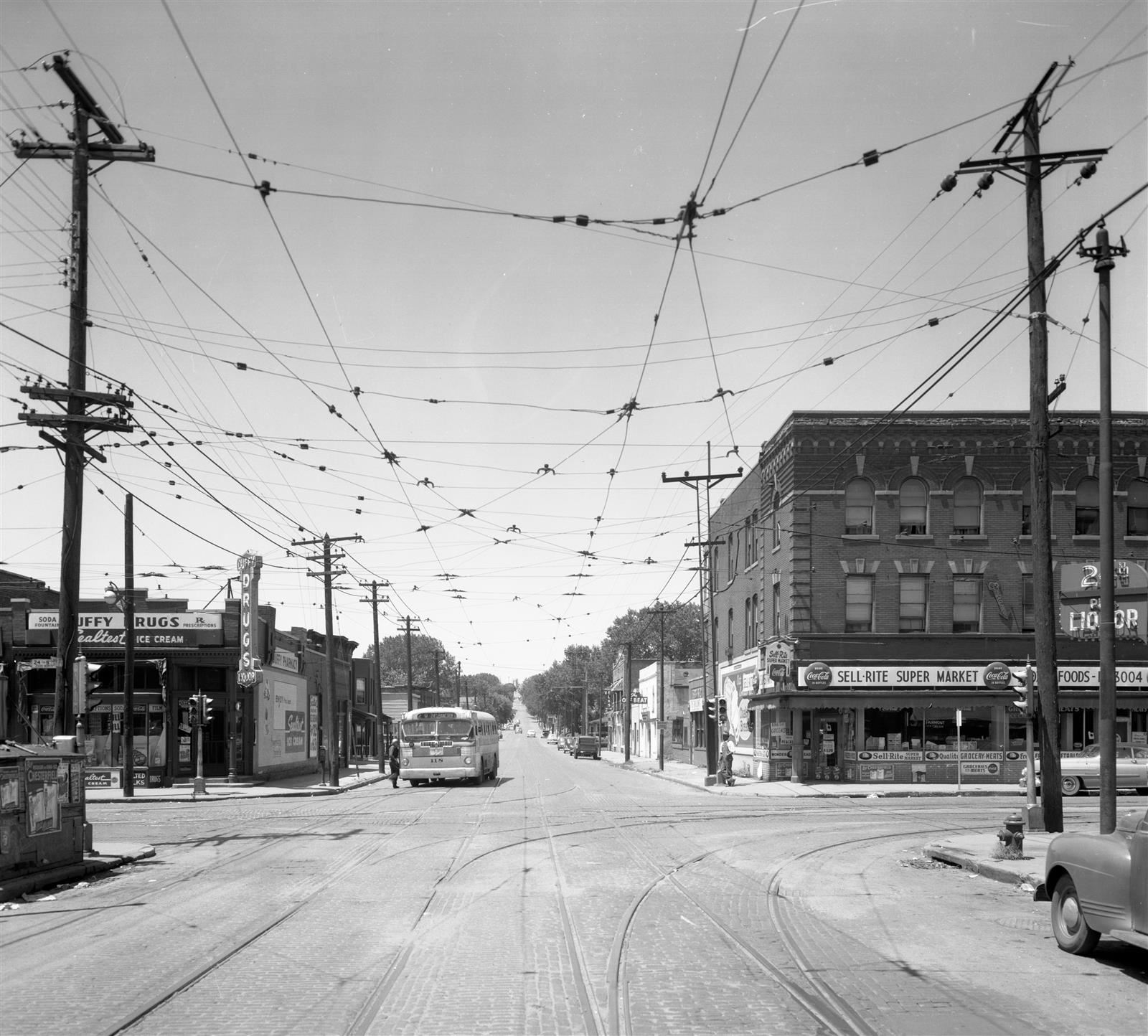
-
A 1 minute MIHV 2021 student video featuring historical images and artifacts that tell the story of Omaha’s 24th and Lake area as a streetcar hub, jazz entertainment district and political campaign stop.
Neighborhood History
The historic 24th and Lake area known as the Near North Side has served many purposes over the years. When Omaha was incorporated in 1854, it was still a rural place. In 1860, it began to change as Northern and Western Europeans moved to Omaha, followed by a second wave of Italians, Eastern Europeans and Jews. A third wave from 1900 to 1929 brought German, Irish and Eastern European immigrants. The neighborhood developed as a Jewish commercial district. Beginning after World War I, Black people migrated to the neighborhood to escape violence and discrimination from Jim Crow laws in the Southern States. The draw to Omaha? Jobs offered by railroad and stockyard companies. Photo: 24th and Lake Streets looking west in 1952. (The Durham Museum Archives-BF6153-892)
A short MIHV student video offering a brief history of the Great Migration and the African American experience of moving to Omaha.
By the 1940s, the 24th and Lake intersection was recognized as the heart of Omaha’s Black community. Bustling businesses, stores galore and prominent professional offices – all within walking distance. Plus, entertainment for all ages at theaters, a bowling alley, pool halls and even a miniature golf course.
In the 1960s, a series of rebellions launched by Black Near North Side residents as political claims to civic, recreational and employment resources accelerated patterns of disinvestment and discrimination. Beginning in the 1980s and continuing to the present day, local residents attempted to spur commercial and economic reinvestment in the neighborhood by promoting a cultural arts and entertainment hub, known as the North 24th Street Jazz District, to pay tribute to the area's musical roots while striving to ensure its revitalization and future success. Other recent proposals call for the creation of a hiking and biking trail along the nearby North Freeway corridor.
Two local publications are working to promote the people, businesses and developments in the area.
Omaha Star
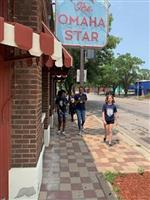
The Omaha Star is a newspaper founded in 1938 by Mildred Brown and her husband S. Edward Gilbert. Mildred took over the publication in 1943 and became one of the few female Black publishers in the country and was active in Omaha’s civil rights movement. Housed in the historic Omaha Star building in Omaha's Near North Side area, today the Omaha Star is the only remaining African-American newspaper in the City and the only one still printed in Nebraska. In 2020, Terri Sanders took over the publication, making her the fifth female black owner of the newspaper.
A short MIHV 2021 student video interviewing Omaha Star publisher Terri Sanders. Sanders shares the background on Mildred Brown and the Omaha Star.
Revive Omaha!
Started in 2008 by Willie and Yolanda Barney, the publication promotes African American businesses and professionals.
Project Site History
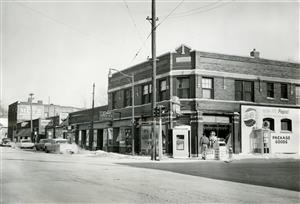
At 24th and Lake, the earliest business listed in the Omaha World-Herald archives was a bakery in 1908. By 1910, there was a brick commercial building at the northeast corner of 24th and Lake, known as Berenstein Grocery; by 1918, the rest of the block was built with other one- and two-story brick commercial buildings. Businesses over the years have included L.M. Smith Shoe Repair, Pitler Plumbing, M&N Radio Shop, Eva’s Dress Shop and Carter’s Café. In 1964, the entire block of buildings on the east side of 24th Street between Lake and Ohio Streets were demolished for the construction of a Safeway grocery store and Skaggs drugstore. Photo: Northeast corner of 24th and Lake Streets in 1963. (Omaha World-Herald Photo)
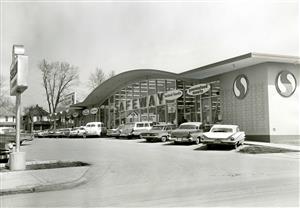 Safeway opened in November 1964 and faced accusations from Black residents of the Near North Side of discriminatory hiring practices and price gouging; in 1968, just six of the store’s 20 employees were Black. Photo: The new Safeway store at 2525 N. 24th St. on April 4, 1965 looking from Lake Street. (Omaha World-Herald Photo)
Safeway opened in November 1964 and faced accusations from Black residents of the Near North Side of discriminatory hiring practices and price gouging; in 1968, just six of the store’s 20 employees were Black. Photo: The new Safeway store at 2525 N. 24th St. on April 4, 1965 looking from Lake Street. (Omaha World-Herald Photo) In July 1966, the store and its parking lot were the original site of the first of a series of rebellions launched by Black residents as a political response to police brutality, employment discrimination, housing segregation, lack of recreational opportunities, and poor educational facilities. In 1968, the Black protesters vandalized the store amidst another rebellion triggered by protests following presidential candidate George Wallace’s appearance at the City Auditorium.
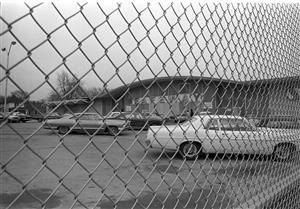
Following these uprisings, Safeway erected an 11-foot chain-link fence with barbed wire around the perimeter of the parking lot, prompting boycotts from Black residents of the Near North Side who nicknamed the store “the compound.” In November 1968, almost four years to the day it opened, Safeway announced it would close its location at 24th and Lake. Photo: A chain link fence and boarded up windows at the Safeway store in November 1968. (The Durham Museum Archives-RP-35mm-1524-003)
In the early 1970s, the North Omaha Community Development Council began attempts to promote the building’s reuse as a grocery store or community space but faced financial hurdles as insurance companies evacuated the neighborhood or cancelled existing policies following the rebellions in 1966, 1968 and 1969.
By 1981, the Canar Manufacturing Company, a furniture company, operated out of the former Safeway building. That same year, the barbed wire fence was removed and replaced with a “less hostile,” but nevertheless still controversial, fence set back from the street. At this time, North Omaha Community Development Inc. relandscaped the corner as part of a broader economic revitalization plan that included the creation of the Blue Lion Center on the southeast corner of 24th and Lake Street.
In 1983, The Omaha Business and Technological Center, a Minneapolis-based firm to provide office space to stimulate fledgling local business, operated out of the former Safeway.
In May 2021, Seventy Five North Revitalization announced its intent to demolish the former Safeway building.
MIHV 2021 student video featuring historical images of Omaha’s Black community plus an interview with Preston Love Jr. on the 24th and Lake’s history and future.
Project Site Plan
The vision for the building is to provide everything within walking distance. On Level One there will be a grocery store plus other spaces for local businesses. On the east side of the building is an events area where rolling paned-glass garage doors go up for spring and summer events and close for fall and winter events. In the northeast corner is a workout area for the public and residents. Outside, in the back of the northwest corner, is a parking lot for patrons of the stores on Level One.
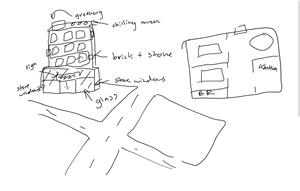
Levels two and three are apartments, including a mix of studios, 1- and 2-bedroom spaces. On top of the building is a rooftop deck, a community garden offering free produce and a green space filled with a mix of pollinator plants and trees to reduce air pollution. The roof top will also include a space for residents and friends to gather. An underground garage provides space for residents' cars and/or storage.
The project is named Twogether as One. “We want to spark a new beginning in the area. The logo is a daisy which signifies a new beginning.
2021 MIHV Project
Student Reflections
-
I didn’t know anything about Omaha’s history until this program. To the booming music and businesses all the way up 24th street to the bad history of racism down Lake Street. I want to save the district from gentrification so the city can light up again. -Jessica H.
Not only did this program help me grow academically, but it also helped me socially. I realized that everyone has talents, and I should trust that they can use it well! -Myo S.
Resources
-
Interviews - July 2021:
Manne Cook, SparkCDI
Eric Ewing, Great Plains Black History Museum
Ashley Kuhn, Blair Freeman
Preston Love Jr., Community Elder, 4Urban
Rod Mullin, Community Elder and Educator
Terri Sanders, Omaha Star
Archives:
Great Plains Black History Museum
Mildred D. Brown Memorial Study Center
Omaha World-Herald Photo Archives
Publications:
North 24th and Lake Streets Historic District, National Register of Historic Places Nomination 2015
Chatelain, Dirk. 24th and Glory: The Intersection of Civil Rights and Omaha’s Greatest Generation of Athletes. Omaha World-Herald Publisher, 2019. Print
Orr, Richard. O&CB Streetcars of Omaha and Council Bluffs. 1996. Print
Omaha Historic Streetcar System an Intensive Level Survey of Preservation Resources. 2017
Omaha World-Herald (online), 11 Nov 1964 page 6., Safeway-Super S at 24th and Lake Sts. Opens
Omaha World-Herald (online), 26 Nov 1968 page 3. 24th and Lake Store is Closing
Omaha Star (online), 2 Jan 1969 page 1. The Wash Line Column by Charles Washington
Omaha World-Herald (online), 8 Oct 1981 page 19. Groundbreaking set at 24th & Lake

